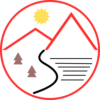Fairbanks is located in the Tanana Valley in the interior of Alaska. During the winter months it is often the case that cold air is trapped at ground level and a warmer layer of air lies overhead. Air temperatures increase with altitude, which is the opposite of the normal condition. This situation is called an inversion. In addition to providing opportunities for scenic photography, an inversion has effects on the local air quality.
In normal circumstances, air temperatures decrease with altitude. Hot exhaust gases rise through the surrounding cooler air because their higher temperature makes them less dense than the cooler air. They float upwards like air bubbles through water. As the exhaust gases rise, they cool, but they remain warmer than the surrounding air long enough to rise well above the ground and blow away before they can settle back down.
During an inversion, the exhaust gases can only rise a short distance before they reach an air layer of the same temperature. At that height they have no density difference from the surrounding air and cannot rise higher. Depending on the circumstances, the exhaust gases may settle back to the ground before they are blown away from the area. In the picture, you can see that the lower side of the exhaust plume is spreading more than the upper side.
During the winter we often have air quality alerts. In the past, the winter air quality grew so bad that the federal government finally required improvements. Now, to help reduce the problem, the local government offers financial incentives for people to improve their home heating systems and there are standards in place for the minimum quality of heating systems allowed when homes are purchased. Some people still complain about having to use cleaner-burning fuel, having to burn their fuel efficiently, and not let unburnt fuel go up the chimney with the exhaust, but compliance is improving as time goes by. It is subjective, but I don’t notice the air quality problem as much as I used to.





Fascinating – intellectually and visually.